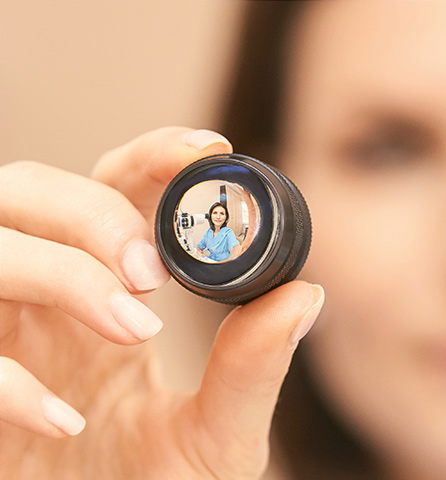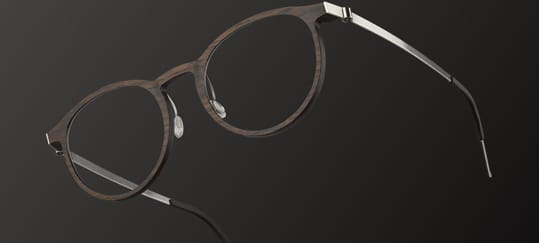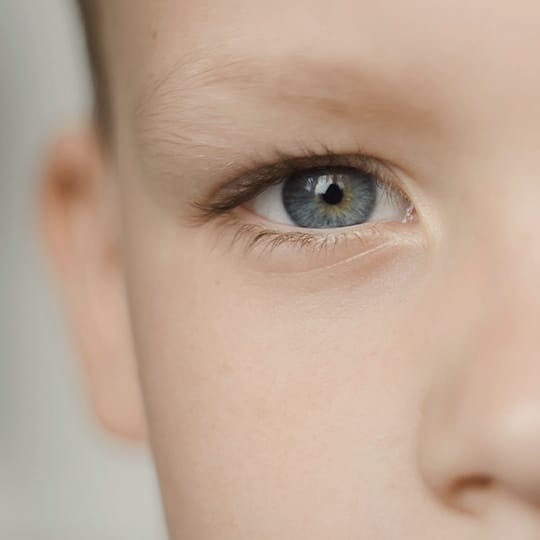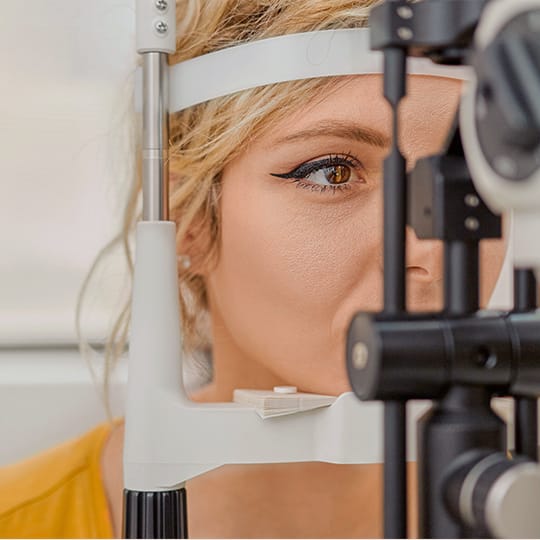Protect Your Child’s Sight from Myopia Progression
Myopia is one of the most common vision conditions worldwide, and it’s growing. In 2000, roughly 23% of the world population had myopia, and researchers expect this to expand to nearly 50% of the population by 2050.
Myopia is easily corrected with glasses or contacts, but myopia control options help slow myopia progression, reducing the risk of high myopia and its complications. Discuss your options with your optometrist.


What Is Myopia?
Myopia is also known as nearsightedness. If your child has myopia, they can see objects close to them clearly but can’t focus on objects in the distance.
Myopia is a refractive error caused by the eye growing too long or the cornea becoming too curved. In these cases, the light that enters the eye can’t reach the retina. This is what causes the inability to focus.
30% of Canadians have myopia. Many people develop myopia vision as children, but it usually stabilizes around 20.
Myopia Control Techniques
You may be wondering, “can’t we just fix this once they’re done growing?” Unfortunately, allowing myopia to progress increases the chances of high myopia, which can be tied to problems like glaucoma, cataracts, and retinal detachment.
Thankfully, the eye’s growth is the very thing we harness to curb myopia’s progression. Adjusting the curvature of the eye while your child is still growing can slow the progression of myopia.
Atropine Drops
Atropine eye drops have been used to slow myopia progression for some time, and studies vouch for their effectiveness. These drops dilate the pupil and freeze the focusing mechanism of the eye.
There may be some drawbacks, including light sensitivity or discomfort, but your optometrist can prescribe an appropriate dose for your child.
Orthokeratology Lenses
Orthokeratology lenses (ortho-k) are gas-permeable contact lenses worn overnight to gently reshape the cornea (the front surface of the eye).
When worn while sleeping every night, ortho-k lenses usually provide clear vision during the day without other corrective aids.
Multifocal Contacts Lenses
Multifocal contact lenses work by having sections or layers of the lens that address different aspects of vision. The lens types are separated into concentric, aspheric, or segmented lenses.
Studies show a 50% reduction in myopia progression over 2 years in children who used multifocal contacts. See if multifocal lenses are suitable for your child.
Set Your Child Up for Visual Success
Early treatment is key to preventing more severe eye issues later in life, and myopic vision is no exception to that. Book a children’s eye exam to keep tabs on your child’s vision and explore their myopia control options.
Serving Calgarians at 3 locations
Calgary Downtown
- 403-264-2639
- 403-264-2872
- dt@calgaryoptometry.com
- Suite 110, 840 7 Avenue SW
- Calgary, Alberta T2P 3G2
Office Hours
- Monday: 8:00 AM – 4:30 PM
- Tuesday: 8:00 AM – 4:30 PM
- Wednesday: 8:00 AM – 4:30 PM
- Thursday: 8:00 AM – 4:30 PM
- Friday: 8:00 AM – 4:30 PM
- Saturday: Closed
- Sunday: Closed
Lake Bonavista
- 403-278-8851
- 403-271-5139
- bv@calgaryoptometry.com
- #630, 12100 Macleod Trail SE
- Calgary, Alberta T2J 7G9
*The office is closed between 12:00 pm and 1:00 pm Mondays to Fridays.
Office Hours
- Monday: 8:30 AM – 5:00 PM
- Tuesday: 8:30 AM – 5:00 PM
- Wednesday: 8:30 AM – 5:00 PM
- Thursday: 8:30 AM – 7:00 PM
- Friday: 8:30 AM – 5:00 PM
- Saturday: 8:00 AM – 2:00 PM
- Sunday: Closed
Huntington Hills
- 403-274-5234
- 403-274-1674
- hh@calgaryoptometry.com
- 6530 4 Street NE
- Calgary , Alberta T2K 6H2
*The office is closed between 12:00 pm and 1:00 pm Mondays to Fridays.
Office Hours
- Monday: 8:30 AM – 5:00 PM
- Tuesday: 8:30 AM – 7:00 PM
- Wednesday: 8:30 AM – 5:00 PM
- Thursday: 8:30 AM – 5:00 PM
- Friday: 8:30 AM – 5:00 PM
- Saturday: 8:00 AM – 2:00 PM
- Sunday: Closed

EXPLORE OUR SERVICES
Our Brands








Our Google Reviews


Our Blog
Can Myopia Be Reversed?
Eye ConditionsYou’ve noticed your child squinting at the TV or holding books closer to their face. Maybe they’ve complained about not being able to see the board at school clearly. As a parent, you naturally wonder if there’s a way to fix this vision problem permanently. Calgary Optometry Centre understands these concerns and helps families navigate […]
What Is IPL Treatment for Dry Eyes?
Dry EyeIf you’ve been dealing with scratchy, burning eyes that make daily activities uncomfortable, you’re not alone. Many families struggle with dry eye symptoms that can affect everything from reading bedtime stories to driving safely at night. Understanding what causes dry eye can help you explore effective treatment options, and scheduling how long does an eye […]
What Does 20/40 Vision Mean?
Eye ExamWhen you hear terms like 20/20 or 20/40 during a comprehensive eye exam, you may wonder what they really mean for your family’s sight. These numbers are simply a way for us to measure the sharpness of your vision from a distance. Understanding them is the first step toward keeping everyone’s eyes healthy and happy. […]
Can Myopia Be Reversed?

You’ve noticed your child squinting at the TV or holding books closer to their face. Maybe they’ve complained about not being able to see the board at school clearly. As a parent, you naturally wonder if there’s a way to fix this vision problem permanently. Calgary Optometry Centre understands these concerns and helps families navigate […]
What Is IPL Treatment for Dry Eyes?

If you’ve been dealing with scratchy, burning eyes that make daily activities uncomfortable, you’re not alone. Many families struggle with dry eye symptoms that can affect everything from reading bedtime stories to driving safely at night. Understanding what causes dry eye can help you explore effective treatment options, and scheduling how long does an eye […]
What Does 20/40 Vision Mean?

When you hear terms like 20/20 or 20/40 during a comprehensive eye exam, you may wonder what they really mean for your family’s sight. These numbers are simply a way for us to measure the sharpness of your vision from a distance. Understanding them is the first step toward keeping everyone’s eyes healthy and happy. […]







